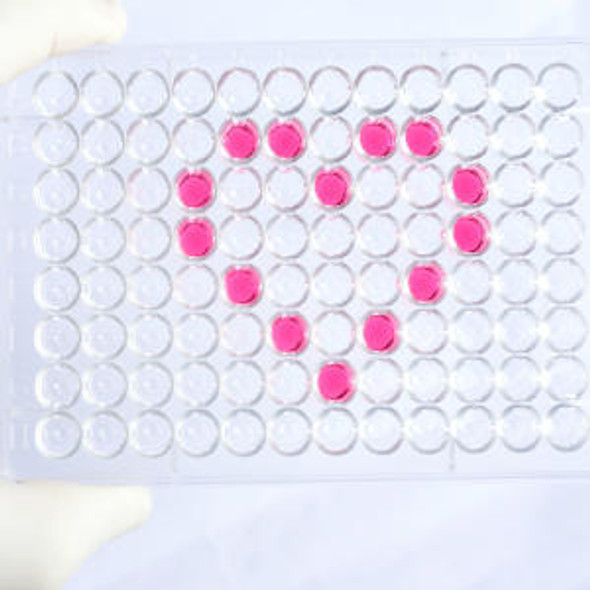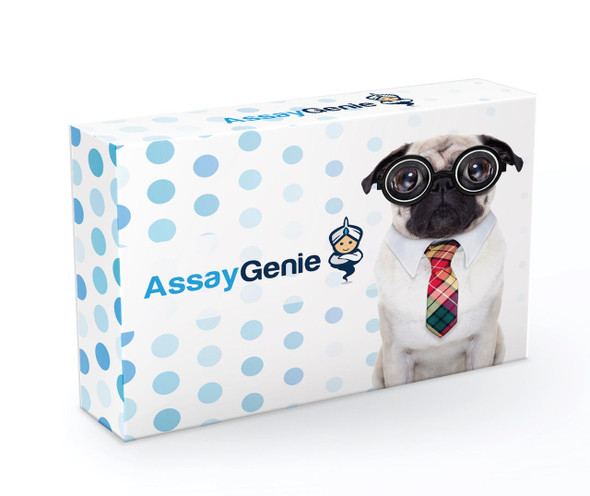Human Cell Biology ELISA Kits 5
Human AGT (Angiotensinogen) ELISA Kit (HUES01529)
- SKU:
- HUES01529
- Product Type:
- ELISA Kit
- Size:
- 96 Assays
- Uniprot:
- P01019
- Sensitivity:
- 0.94ng/mL
- Range:
- 1.56-100ng/mL
- ELISA Type:
- Sandwich
- Synonyms:
- ANHU, SERPINA8
- Reactivity:
- Human
- Sample Type:
- Serum, plasma and other biological fluids
- Research Area:
- Cell Biology
Description
| Assay type: | Sandwich |
| Format: | 96T |
| Assay time: | 4.5h |
| Reactivity: | Human |
| Detection Method: | Colormetric |
| Detection Range: | 1.56-100 ng/mL |
| Sensitivity: | 0.94 ng/mL |
| Sample Volume Required Per Well: | 100µL |
| Sample Type: | Serum, plasma and other biological fluids |
| Specificity: | This kit recognizes Human AGT in samples. No significant cross-reactivity or interference between Human AGT and analogues was observed. |
This ELISA kit uses Sandwich-ELISA as the method. The micro ELISA plate provided in this kit has been pre-coated with an antibody specific to Human AGT. Standards or samples are added to the appropriate micro ELISA plate wells and combined with the specific antibody. Then a biotinylated detection antibody specific for Human AGT and Avidin-Horseradish Peroxidase (HRP) conjugate are added to each micro plate well successively and incubated. Free components are washed away. The substrate solution is added to each well. Only those wells that contain Human AGT, biotinylated detection antibody and Avidin-HRP conjugate will appear blue in color. The enzyme-substrate reaction is terminated by adding Stop Solution and the color turns yellow. The optical density (OD) is measured spectrophotometrically at a wavelength of 450 nm ± 2 nm. The OD value is proportional to the concentration of Human AGT. The concentration of Human AGT in samples can be calculated by comparing the OD of the samples to the standard curve.
| UniProt Protein Function: | angiotensin: Essential component of the renin-angiotensin system (RAS), a potent regulator of blood pressure, body fluid and electrolyte homeostasis. In response to lowered blood pressure, the enzyme renin cleaves angiotensinogen to produce angiotensin-1 (angiotensin 1-10). Angiotensin-1 is a substrate of ACE (angiotensin converting enzyme) that removes a dipeptide to yield the physiologically active peptide angiotensin-2 (angiotensin 1- 8). Angiotensin-1 and angiotensin-2 can be further processed to generate angiotensin-3 (angiotensin 2-8), angiotensin-4 (angiotensin 3-8). Angiotensin 1-7 is cleaved from angiotensin-2 by ACE2 or from angiotensin-1 by MME (neprilysin). Angiotensin 1-9 is cleaved from angiotensin-1 by ACE2. Genetic variations in AGT are a cause of susceptibility to essential hypertension (EHT). Essential hypertension is a condition in which blood pressure is consistently higher than normal with no identifiable cause. Defects in AGT are a cause of renal tubular dysgenesis (RTD). RTD is an autosomal recessive severe disorder of renal tubular development characterized by persistent fetal anuria and perinatal death, probably due to pulmonary hypoplasia from early-onset oligohydramnios (the Potter phenotype). Belongs to the serpin family. |
| UniProt Protein Details: | Protein type:Secreted, signal peptide; Secreted Chromosomal Location of Human Ortholog: 1q42. 2 Cellular Component: extracellular region; extracellular space Molecular Function:growth factor activity; hormone activity; protein binding; serine-type endopeptidase inhibitor activity; type 1 angiotensin receptor binding; type 2 angiotensin receptor binding Biological Process: activation of NF-kappaB transcription factor; angiotensin maturation; blood vessel remodeling; cell-cell signaling; G-protein coupled receptor protein signaling pathway; G-protein signaling, coupled to cGMP nucleotide second messenger; kidney development; negative regulation of nerve growth factor receptor signaling pathway; nitric oxide mediated signal transduction; positive regulation of cellular protein metabolic process; positive regulation of cytokine production; positive regulation of epidermal growth factor receptor signaling pathway; positive regulation of fibroblast proliferation; positive regulation of inflammatory response; positive regulation of NAD(P)H oxidase activity; positive regulation of peptidyl-tyrosine phosphorylation; positive regulation of phosphoinositide 3-kinase cascade; positive regulation of transcription, DNA-dependent; regulation of blood pressure; renal system process; renin-angiotensin regulation of blood vessel size; response to muscle activity involved in regulation of muscle adaptation Disease: Hypertension, Essential; Renal Tubular Dysgenesis |
| NCBI Summary: | The protein encoded by this gene, pre-angiotensinogen or angiotensinogen precursor, is expressed in the liver and is cleaved by the enzyme renin in response to lowered blood pressure. The resulting product, angiotensin I, is then cleaved by angiotensin converting enzyme (ACE) to generate the physiologically active enzyme angiotensin II. The protein is involved in maintaining blood pressure and in the pathogenesis of essential hypertension and preeclampsia. Mutations in this gene are associated with susceptibility to essential hypertension, and can cause renal tubular dysgenesis, a severe disorder of renal tubular development. Defects in this gene have also been associated with non-familial structural atrial fibrillation, and inflammatory bowel disease. [provided by RefSeq, Jul 2008] |
| UniProt Code: | P01019 |
| NCBI GenInfo Identifier: | 113880 |
| NCBI Gene ID: | 183 |
| NCBI Accession: | P01019. 1 |
| UniProt Secondary Accession: | P01019,Q16358, Q16359, Q96F91, |
| UniProt Related Accession: | P01019 |
| Molecular Weight: | 53,154 Da |
| NCBI Full Name: | Angiotensinogen |
| NCBI Synonym Full Names: | angiotensinogen |
| NCBI Official Symbol: | AGT |
| NCBI Official Synonym Symbols: | ANHU; SERPINA8 |
| NCBI Protein Information: | angiotensinogen |
| UniProt Protein Name: | Angiotensinogen |
| UniProt Synonym Protein Names: | Serpin A8 |
| Protein Family: | Angiotensinogen |
| UniProt Gene Name: | AGT |
| UniProt Entry Name: | ANGT_HUMAN |
As the OD values of the standard curve may vary according to the conditions of the actual assay performance (e. g. operator, pipetting technique, washing technique or temperature effects), the operator should establish a standard curve for each test. Typical standard curve and data is provided below for reference only.
| Concentration (ng/mL) | O.D | Average | Corrected |
| 100 | 2.261 2.273 | 2.267 | 2.211 |
| 50 | 1.569 1.573 | 1.571 | 1.515 |
| 25 | 0.943 0.933 | 0.938 | 0.882 |
| 12.5 | 0.467 0.491 | 0.479 | 0.423 |
| 6.25 | 0.241 0.213 | 0.227 | 0.171 |
| 3.13 | 0.165 0.141 | 0.153 | 0.097 |
| 1.56 | 0.104 0.108 | 0.106 | 0.05 |
| 0 | 0.05 0.062 | 0.056 | -- |
Precision
Intra-assay Precision (Precision within an assay): 3 samples with low, mid range and high level Human AGT were tested 20 times on one plate, respectively.
Inter-assay Precision (Precision between assays): 3 samples with low, mid range and high level Human AGT were tested on 3 different plates, 20 replicates in each plate.
| Intra-assay Precision | Inter-assay Precision | |||||
| Sample | 1 | 2 | 3 | 1 | 2 | 3 |
| n | 20 | 20 | 20 | 20 | 20 | 20 |
| Mean (ng/mL) | 5.18 | 13.08 | 46.09 | 4.68 | 14.24 | 45.85 |
| Standard deviation | 0.34 | 0.75 | 2.12 | 0.26 | 0.61 | 1.89 |
| C V (%) | 6.56 | 5.73 | 4.60 | 5.56 | 4.28 | 4.12 |
Recovery
The recovery of Human AGT spiked at three different levels in samples throughout the range of the assay was evaluated in various matrices.
| Sample Type | Range (%) | Average Recovery (%) |
| Serum (n=5) | 92-106 | 98 |
| EDTA plasma (n=5) | 88-102 | 95 |
| Cell culture media (n=5) | 85-100 | 92 |
Linearity
Samples were spiked with high concentrations of Human AGT and diluted with Reference Standard & Sample Diluent to produce samples with values within the range of the assay.
| Serum (n=5) | EDTA plasma (n=5) | Cell culture media (n=5) | ||
| 1:2 | Range (%) | 87-97 | 86-97 | 95-107 |
| Average (%) | 92 | 92 | 101 | |
| 1:4 | Range (%) | 94-104 | 80-93 | 81-95 |
| Average (%) | 99 | 87 | 87 | |
| 1:8 | Range (%) | 88-103 | 85-99 | 82-95 |
| Average (%) | 94 | 92 | 88 | |
| 1:16 | Range (%) | 86-100 | 84-95 | 83-97 |
| Average (%) | 92 | 89 | 90 |
An unopened kit can be stored at 4°C for 1 month. If the kit is not used within 1 month, store the items separately according to the following conditions once the kit is received.
| Item | Specifications | Storage |
| Micro ELISA Plate(Dismountable) | 8 wells ×12 strips | -20°C, 6 months |
| Reference Standard | 2 vials | |
| Concentrated Biotinylated Detection Ab (100×) | 1 vial, 120 µL | |
| Concentrated HRP Conjugate (100×) | 1 vial, 120 µL | -20°C(shading light), 6 months |
| Reference Standard & Sample Diluent | 1 vial, 20 mL | 4°C, 6 months |
| Biotinylated Detection Ab Diluent | 1 vial, 14 mL | |
| HRP Conjugate Diluent | 1 vial, 14 mL | |
| Concentrated Wash Buffer (25×) | 1 vial, 30 mL | |
| Substrate Reagent | 1 vial, 10 mL | 4°C(shading light) |
| Stop Solution | 1 vial, 10 mL | 4°C |
| Plate Sealer | 5 pieces | |
| Product Description | 1 copy | |
| Certificate of Analysis | 1 copy |
- Set standard, test sample and control (zero) wells on the pre-coated plate and record theirpositions. It is recommended to measure each standard and sample in duplicate. Note: addall solutions to the bottom of the plate wells while avoiding contact with the well walls. Ensuresolutions do not foam when adding to the wells.
- Aliquot 100 µL of standard solutions into the standard wells.
- Add 100 µL of Sample / Standard dilution buffer into the control (zero) well.
- Add 100 µL of properly diluted sample (serum, plasma, tissue homogenates and otherbiological fluids) into test sample wells.
- Cover the plate with the sealer provided in the kit and incubate for 90 min at 37 °C.
- Aspirate the liquid from each well, do not wash. Immediately add 100 µL of BiotinylatedDetection Ab working solution to each well. Cover the plate with a plate seal and gently mix. Incubate for 1 hour at 37 °C.
- Aspirate or decant the solution from the plate and add 350 µL of wash buffer to each welland incubate for 1-2 minutes at room temperature. Aspirate the solution from each well andclap the plate on absorbent filter paper to dry. Repeat this process 3 times. Note: a microplatewasher can be used in this step and other wash steps.
- Add 100 µL of HRP Conjugate working solution to each well. Cover with a plate seal andincubate for 30 min at 37 °C.
- Aspirate or decant the solution from each well. Repeat the wash process for five times asconducted in step 7.
- Add 90 µL of Substrate Reagent to each well. Cover with a new plate seal and incubate forapproximately 15 min at 37 °C. Protect the plate from light. Note: the reaction time can beshortened or extended according to the actual color change, but not by more than 30min.
- Add 50 µL of Stop Solution to each well. Note: Adding the stop solution should be done inthe same order as the substrate solution.
- Determine the optical density (OD value) of each well immediately with a microplate readerset at 450 nm.






